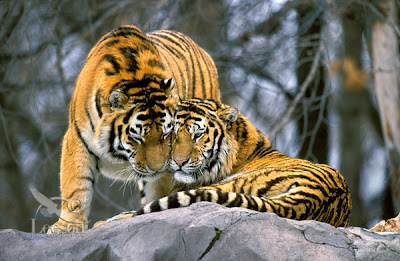Animal Unique | Siberian Tiger | Siberian tigers or Amun tigers are large carnivores in coldest areas of the earth. They are the world's largest cat and one of the most endangered species. Approximately 80% of Siberian tigers live in the coniferous, scrub oak and birch forests of the Primorsky Krai region of Russia (eastern Russia). Today, their number in China and Korea are much reduced because of illegal poaching. It is estimated that approximately 350 to 400 tigers in the wild and 490 are in zoos. Important habitat for the Siberian tigers are Korean pine broadleaf forest with a complex composition and structure. This tigers prefer to live a lonely life and large areas, some of these areas is greater than 4000 square miles.
Scientific classification
Kingdom: Animalia
Phylum: Chordata
Class: Mammalia
Order: Carnivora
Family: Felidae
Subfamily: Pantherinae
Genus: Panthera
Species: P. tigris
Subspecies: P. tigris altaica
Kingdom: Animalia
Phylum: Chordata
Class: Mammalia
Order: Carnivora
Family: Felidae
Subfamily: Pantherinae
Genus: Panthera
Species: P. tigris
Subspecies: P. tigris altaica
Siberian tigers are huge and the possession and impressive body frame. Their orange color is actually paler than other tigers and it is widely spaced brown stripes instead of black. It has a white chest and belly and a thick ruff of hair around her neck. The skull of the Siberian tiger is distinguished by its larger overall size, but also the development of the ridge, the height and strength greater than that of other tigers and lion. A female skull is always smaller and has never been so heavily built and robust as that of a man.
The ground color of the Siberian tigers' fur is often very pale, especially in winter coat. However, variations in substantially populations. Variation is also in the shape, length, and partly in the color of the dark lines, which have been described as a dark brown or black. Generally, the coat of the western population was brighter and more uniform than that of the Far East populations. The summer coat is coarse, while the winter is closer, longer, softer and softer. The winter fur is often quite rough on the trunk, and is clearly more on the head, almost to the ears. The whiskers and hair on the back of the head and upper neck are also greatly extended. The color of the winter coat is generally less bright and rust in relation to the summer coat. As a result of the winter coat of the greater length, the stripes wider with less defined outlines.
Siberian tigers have 20 pounds of meat for their daily diet. They mostly eat deer, elk and wild boar. Monkeys, birds, frogs and fish form their diet in times of food scarcity. Tigers may prey on both brown and black bears at ungulate populations decrease. They most typically attacking brown bears in the vicinity of the hibernaculum in the winter. Brown bears are attacked by tigers more often than black bears, as a result of their habit of living in more open areas and their inability to climb trees. When hunting bears, tigers will position themselves in the lee of a rock or a fallen tree, waiting for the bear to pass. When the bear goes, the tiger shoot from an overhead position and grab the bear under the chin with a paw and throat with the other.
Siberian tigers can be very fast speeds of up to 50 mph running, however, they can only maintain this speed over short distances. In fact, only one out of ten of their hunting also actually to be successful. They hunt mainly at night; their excellent night vision and highly developed senses of hearing and smell allow. The night vision goggles six times better than that of humans. Siberian tigers living in the wild to survive as long as 15 years, but those in captivity have a smaller life. In fact, Siberian tigers survive frost and in case of a fight, they warn the invaders advance by rattling their tails.
Siberian tigers breeding season tends to be from December to January. The normal gestation period is three to three and a half months. Siberian tigers are sexually mature at four years. They mate at any time of the year. A female signals her receptivity by leaving urine deposits and scratches on trees. An average litter size is three or four cubs. The cubs are born blind and are about as big as a house cat. After about two weeks eyes open and their teeth begin to grow. They are weaned at six months and independently by 18 months. They will hunt on their own to start in their first year, but they do not let their mother and their own territory to the achievement of three to five years old. Unfortunately it is common that only one young per litter to survive to maturity.
The shrinkage of Siberian tiger habitat is one of the most important reason, except that their number is reduced poaching. In most cases, the timber has been carried out illegal. Although it is illegal to kill a tiger, tigers are still poached today because their body parts can be sold on the black market for large sums of money. The tiger parts are sold for their fur and use in traditional Chinese medicine. Forrest fragmentation and poaching have both taken their toll on the tiger numbers, but in Korea logging of Korean Pines seems to constitute the greatest threat. Korean pines produce a good quality wood that is mainly used for pencil production. The Pine is crucial for the survival of the tiger population, because the nuts are an important food source for elk, deer and wild boar - the main prey of the tiger. The survival of the Siberian tiger is largely dependent on the protection of Korean Pine.
Animal Unique







Tidak ada komentar:
Posting Komentar